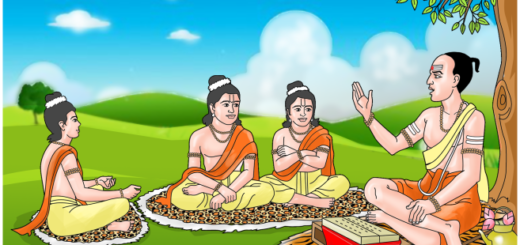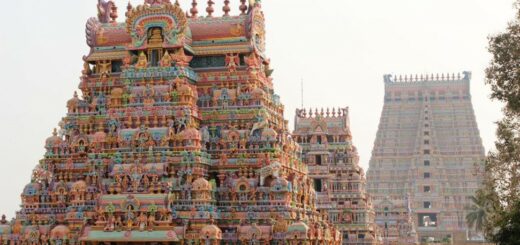Art & Culture: Miniature Painting
1. THE PALA SCHOOL (11th to 12th centuries)

- The earliest examples of miniature painting in India exist in the form of illustrations to the religious texts on Buddhism executed under the Palas of the eastern India and the Jain texts executed in western India during the 11th-12th centuries A.D.
- The Pala period (750 A.D. to the middle of the 12th century) witnessed the last great phase of Buddhism and of the Buddhist art in India.
- The Buddhist monasteries (mahaviharas) of Nalanda, Odantapuri,Vikramsila and Somarupa were great centres of Buddhist learning and art.
- A large number of manuscripts on palm-leaf relating to the Buddhist themes were written and illustrated with the images of Buddhist deities at these centres which also had workshops for the casting of bronze images.
- Students and pilgrims from all over South-East Asia gathered there for education and religious instruction. They took back to their countries examples of Pala Buddhist art, in the form of bronzes and manuscripts which helped to carry the Pala style to Nepal, Tibet, Burma, Sri Lanka and Java etc.
- The surviving examples of the Pala illustrated manuscripts mostly belong to the Vajrayana School of Buddhism.

The stupa of Sariputta at Nalanda, Bihar
- The Pala painting is characterised by sinuous line and subdued tones of colour. It is a naturalistic style which resembles the ideal forms of contemporary bronze and stone sculpture, and reflects some feeling of the classical art of Ajanta.
- A fine example of the typical Buddhist palm-leaf manuscript illustrated in the Pala style exists in the Bodleian Library, Oxford, England. It is a manuscript of the Astasahasrika Prajnaparamita, or the perfection of Wisdom written in eight thousand lines. It was executed at the monastery of Nalanda in the fifteenth year of the reign of the Pala King, Ramapala, in the last quarter of the eleventh century. The manuscript has illustrations of six pages and also on the insides of both wooden covers.
- The Pala art came to a sudden end after the destruction of the Buddhist monasteries at the hands of Muslim invaders in the first half of the 13th century. Some of the monks and artists escaped and fled to Nepal, which helped in reinforcing the existing art traditions there.
The Western Indian School (12th – 16th Centuries)
 The Western Indian style of painting prevailed in the region comprising Gujarat, Rajasthan and Malwa. The motivating force for the artistic activity in Western India was Jainism just as it was Buddhism in case of the Ajanta and the Pala arts.
The Western Indian style of painting prevailed in the region comprising Gujarat, Rajasthan and Malwa. The motivating force for the artistic activity in Western India was Jainism just as it was Buddhism in case of the Ajanta and the Pala arts.- Jainism was patronised by the Kings of the Chalukya Dynasty who ruled Gujarat and parts of Rajasthan and Malwa from 961 A.D. to the end of the 13th century.
- An enormous number of Jain religious manuscripts were commissioned from 12th to 16th centuries by the princes, their ministers and the rich Jain merchants for earning religious merit. Many such manuscripts are available in the Jain libraries (bhandaras) which are found at many places in Western India.
- The illustrations on these manuscripts are in a style of vigorous distortion. One finds in this style an exaggeration of certain physical traits, eyes, breasts and hips are enlarged. Figures are flat with angularity of features and the further eye protruding into space. This is an art of primitive vitality vigorous line and forceful colours.
- From about 1100 to 1400 A.D., palm-leaf was used for the manuscripts and later on paper was introduced for the purpose.
- TheKalpasutra and the Kalakacharya-Katha, the two very popular Jain texts were repeatedly written and illustrated with paintings.
- Some notable examples are the manuscripts of the Kalpasutra in the Devasano pado Bhandar at Ahmedabad, the Kalpasutra and Kalakacharya-Katha of about 1400 A.D. in the Prince of Wales Museum. Bombay and the Kalpasutra dated 1439 A.D. executed in Mandu, now in the National Museum, New Delhi and the Kalpasutra written and painted in Jaunpur in 1465 A.D.
Other Isolated Styles (1500-1550 A.D.)
- During the 15th century the Persian style of painting started influencing the Western Indian style of painting as is evident from the Persian facial types and hunting scenes appearing on the border’s of some of the illustrated manuscripts of the Kalpasutra.
- Introduction of the use of ultramarine blue and gold colour in the Western Indian manuscripts is also believed to be due to the influence of the Persian painting.
- These Persian paintings, which came to India, were in the form of illustrated manuscripts. A number of such manuscripts were copied in India.
- Some colours used in these types of copies can be seen in the Freer Gallery of Art, Washington and an illustrated manuscript of Bustan of Sadi in the National Museum, New Delhi. The Bustan was executed for Sultan Nadir Shah Khilji of Malwa (1500-1510 A.D.), by one Hajji Mahmud (painter) Shahsuwar (scribe).
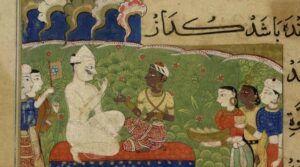
- An illustrated manuscript of the Nimat Nama (Cookery Book) which exists in the Indian Office Library, London is marked by a new trend of painting at Malwa.
- The manuscript was started in the time of Ghiyasaldin Khilji of Malwa (1469-1500 A.D.). A left of this manuscript is illustrated here. In the Nimat Nama style the Persian influence is visible in the scroll like clouds, flowering trees, grassy tufts and flowering plants in the background, female figures and costumes.
- Indian elements are noticeable in some female types and their costumes and ornaments and colours. In this manuscript one can notice the first attempt towards the evolution of new styles of painting by the fusion of the Persian style of Shiraz with the indigenous Indian style.
- The finest examples of painting belonging to the first half of the 16th century are, however, represented by a group of miniatures generally designated as the “Kulhadar Group”. This group includes illustrations of the ‘Chaurapanchasika’ – “Fifty Verses of the Thief by Bilhan, the Gita Govinda, the Bhagavata Purana and Ragamala.
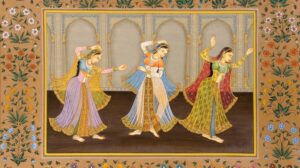
- The style of these miniatures is marked by the use of brilliant contrasting colours, vigorous and angular drawing, transparent drapery and the appearance of conical caps ‘Kulha’ on which turbans are worn by the male figures.
- An example of the Chaurapanchasika miniature shows Champavati standing near a lotus pond.

- This miniature belongs to the N.C. Mehta collection, Bombay. It was executed in the first quarter of the 6th century, probably in Mewar. The style of the painting is purely indigenous derived from the earlier tradition of the Westen Indian art and does not show any influence of either the Persian or the Mughal style of painting.
- Two manuscripts of the Laur Chanda, an Avadhi romance by Mulla Daud, one in the Prince of Wales Museum, Bombay and the other in John Rylands Library, Manchester seem to have been painted at Muslim courts between 1530 to 1540 A.D. They show a mixture of Persian and Indian styles like the Nimat Nama of Malwa. The other two important manuscripts of this period are the Mrigavati and the Mahapurana, a Jain text. They are executed in a style related to Chaurapanchasika style.
The Mughal School (1560-1800 A.D.)
- The origin of the Mughal School of Painting is considered to be a landmark in the history of painting in India.
- With the establishment of the Mughal empire, the Mughal School of painting originated in the reign of Akbar in 1560 A.D.
- Emperor Akbar was keenly interested in the art of painting and architecture. In the beginning of his rule an ateliar of painting was established under the supervision of two Persian masters, Mir Sayyed Ali and Abdul Samad Khan, who were originally employed by his father Humayun. A large number of Indian artists from all over India were recruited to work under the Persian masters.

- The Mughal style evolved as a result of a happy synthesis of the indigenous Indian style of painting and the Safavid school of Persian painting.
- The Mughal style is marked by supple naturalism based on close observation of nature and fine and delicate drawing. It is of an high aesthetic merit. It is primarily aristocratic and secular.
- An illustrated manuscript of the Tuti-nama in the Cleveland Museum of Art (USA) appears to be the first work of the Mughal School.
- The style of painting in this manuscript shows the Mughal style in its formative stage. Shortly after that, between 1564-69 A.D. was completed a very ambitious project in the form of Hamza-nama illustrations on cloth, originally consisting of 1400 leaves in seventeen volumes. The style of Hamza-nama is more developed and refined than that of the Tuti-nama.
- The Hamza-nama illustrations are in a private collection in Switzerland. It shows Mihrdukht shooting arrows at the bird on a multi-staged minaret, from the upper storey of a pavilion. In this miniature one can observe that the architecture is Indo-Persian, the tree types are mainly derived from the Deccani painting and female types are adapted from the earlier Rajasthani paintings, Women are wearing four comered pointed skirts and transparent muslim veils. Turbans worn by men are small and tight, typical of the Akbar period.

- The Mughal style was further influenced by the European paintings which came in the Mughal court, and absorbed some of the Westem techniques like shading and perspective.
- The other important manuscripts illustrated during the period of Akbar are the Gulistan of Sadi dated 1567 in the British Museum, London, the Anwari-Suhavli (a book of fables) dated 1570 in the School of Oriental and African Studies, University of London, another Gulistan of Sadi in the Royal Asiatic Society Library copied at Fatehpur Sikri in 1581 by Muhammad Hussain al-Kashmiri, a Diwan of the poet Amir Shahi in the Bibliotheque Nationale, of the Diwan of Hafiz, theRazm-nama (Persian translation of the Mahabharata) in the Maharaja of Jaipur Museum, Jaipur, the Baharistan of Jami dated 1595 in the Bodleian Library, the Darab-nama in the British Museum, the Akbar-nama (circa 1600) in the Victoria and Albert Museum, London, the Tarikh-i-Alfi dated 1596 A.D. in the Gulistan Library in Tehran, a number of the Babar-nama, a manuscript executed in the last decade of the 16th century, the Twarikh-e-Khandane Taimuria in the Khuda Baksh Library, Patna, the Jog Vashisht dated 1602 in the Chester Beatty Library, Dublin etc. Moreover, a number of paintings of court and hunting scenes and portraits were also executed during the period of Akbar.
Akbar’s court painters
- The list of Akbar’s court painters includes a large number of names. Some of the famous painters other than the two Persian masters already mentioned are Dasvanth, Miskina, Nanha, Knha, Basawan, Manohar, Doulat, Mansur, Kesu, Bhim Gujarati, Dharam Das, Madhu, Surdas, Lal, Shankar Goverdhan and Inayat.
Evolution of Mughal paintings under Jahangir
- Under Jahangir, painting acquired greater charm, refinement and dignity. He had great fascination for nature and took delight in the portraiture of birds, animals and flowers.
- Some important manuscripts illustrated during his period are, an animal fable book called Ayar-i-Danish, some miniatures in the Gulistan and a Diwan of Hafiz. Besides a number of durbar scenes, portraits,
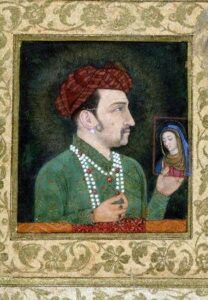 bird, animal and flower studies were also executed during his period. The famous painters of Jahangir are Aqa Riza, Abul Hasan, Mansur, Bishan Das, Manohar, Goverdhan, Balchand, Daulat, Mukhlis, Bhim and Inayat.
bird, animal and flower studies were also executed during his period. The famous painters of Jahangir are Aqa Riza, Abul Hasan, Mansur, Bishan Das, Manohar, Goverdhan, Balchand, Daulat, Mukhlis, Bhim and Inayat. - The portrait of Jahangir illustrated is a typical example of miniature executed during the period of Jahangir.
- It shows Jahangir holding a picture of the Virgin Mary in his right hand. The portrait is remarkable for its superb drawing and fine modelling and realism. There is liberal use of gold colour on the borders which are decorated with floral designs. Text in Persian appears along the border. The portrait is assigned to 1615-20 A.D.
- Following the example of the Mughal Emperor the courtiers and the provincial officers also patronised painting. They engaged artists trained in the Mughal technique of painting. But the artists available to them were of inferior merit, those who could not seek employment in the Imperial Atelier which required only first-rate artists.
- Some notable examples of the Popular Mughal painting are a series of the Razm-nama dated 1616 A.D., a series of the Rasikapriya (1610-1615) and a series of the Ramayana of circa 1610 A.D., in several Indian and foreign museums.
- An example from a series of the Ramayana of the early 17th century in the typical popular Mughal style, from the collection of the National Museum, New Delhi. It shows a fight between the armies of Rama and Ravana in Lanka.
- Rama with his brother Lakshmana is seen in the foreground to the left while Ravana is seen in his court conversing with the demon chiefs inside the golden fort. The drawing is fine but not as refined as observed in the Imperial Mughal painting.

Shah Jahan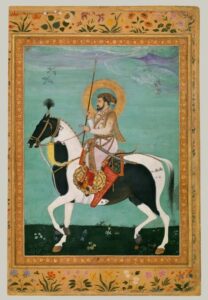
- Under Shah Jahan the Mughal painting maintained its fine quality. But the style, however, became over-ripe during the later period of his rule. Portraiture was given considerable attention by his painters.
- The well-known artists of his period are Bichiter, Chaitaraman, Anup Chattar, Mohammed Nadir of Samarquand, Inayat and Makr.
- Apart from portraiture, other paintings showing groups of ascetics and mystics and a number of illustrated manuscripts were also executed during his period.
- Some noteworthy examples of such manuscripts are the Gulistan and the Bustan of Sadi, copied for the emperor in the first and second years of his reign and the Shah Jahan Nama 1657, at Windsor Castle.
- A miniature in the collection of the National Museum depicts a gathering of Sufis (Muslim divines) who are seen seated in an open space and engaged in discussion. It displays supple naturalism of the Mughal style of the Shah Jahan period. The drawing is refined and the colours have subdued tones. The background is green and the sky is in golden colour. The borders show floral designs in golden colour. The miniature is assigned to circa 1650 A.D.
Aurangzeb and later era
- Aurangzeb was a puritan and therefore did not encourage art. Painting declined during his period and lost much of its earlier quality. A large number of court painters migrated to the provincial courts.
- During the period of Bahadur Shah, there was a revival of the Mughal painting after the neglect shown by Aurangzeb. The style shows an improvement in quality.
- After 1712 A.D. the Mughal painting again started deteriorating under the later Mughals. Though retaining the outer form it became lifeless and lost inherent quality of the earlier Mughal art.
The Deccani Schools (Circa 1560-1800 A.D.)
- Though no pre-Mughal painting from the Deccan are so far known to exist, yet it can safely be presumed that sophisticated schools of painting flourished there, making a significant contribution to the development of the Mughal style in North India.
- Early centres of painting in the Deccan, during the 16th and 17th centuries were Ahmednagar, Bijapur and Golconda. In the Deccan, painting continued to develop independently of the Mughal style in the beginning. However, later in the 17th and 18th centuries it was increasingly influenced by the Mughal style.
Ahmednagar
- The earliest examples of the Ahmednagar painting are contained in a volume of poems written in praise of Hussain Nizam Shah I of Ahmednagar (1553-1565) and his queen. This manuscript known as the ‘Tarif-in-Hussain Shahi and assigned to a period 1565-69 is preserved in the Bharat ltihas Samshodaka Mandala, Poona.
- One of the illustrations depicts the king sitting on the throne and attended by a number of women. The female type appearing in the painting belongs to the northern tradition of Malwa. The Choli (bodice) and long pigtails braided and ending in a tassel are the northern costume. But the long scarf passing round the body is in the southern fashion. The colours used in the painting being rich and brilliant are different from those used in the northern paintings. The Persian influence can be seen in the high horizon, gold sky and the landscape.

- Some other fine examples of the Ahmednagar painting are the “Hindola Raga” of about 1590 A.D. and portraits of Burhan Nizam Shah II of Ahmednagar (1591-96 A.D.) and of Malik Amber of about 1605 A.D. existing in the National Museum, New Delhi and other museums.
Bijapur
- In Bijapur, painting was patronised by Ali Adil Shah I (1558-80 A.D.) and his successor Ibrahim II (1580-1627 A.D.). An encyclopaedia known as the Najum-al-ulum (Stars of Sciences), was illustrated in 1570 A.D. in the reign of Ali Adil Shah I.
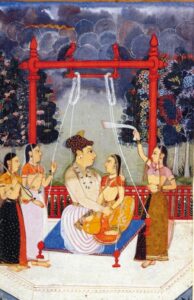
- This manuscript contains 876 miniatures. The ladies appearing in the illustrations are tall and slender and are wearing the South Indian dress. One of the miniatures illustrated here shows the “Throne of Prosperity”. There is influence of the Lepakshi mural painting on the female types. The rich colour scheme, the palm trees, animals and men and women all belong, to the Deccani tradition. The profuse use of gold colour, some flowering plants and arabesques on the top of the throne are derived from the Persian tradition.
- Ibrahim II (1580-1627 A.D.) was a musician and author of a book, the Naurasnama., on the subject. It is believed that a number of the Ragamala paintings were commissioned in various museums and private collections. A few contemporary portraits of Ibrahim II are also available in several museums.
Golconda
- The earliest paintings identified as Golconda work are a group of five charming paintings of about 1590 A.D. painted in the period of Muhammad Quli Quta Shah (1580-1611)
- They show dancing girls. One of the miniatures illustrated shows the king in his court watching a dance performance. He wears the white muslim coat with embroidered vertical band, a typical costume associated with the Golconda court. Gold colour has been lavishly used in painting the architecture, costume, jewellery and vessels etc.
- Other outstanding examples of the Golconda painting are “Lady with the Myna bird”, about 1605 A.D., an illustrated manuscript of a Sufi poem (1605-15 A.D.) and a couple of portraits showing a poet in a garden and an elegantly dressed young man seated on a golden stool and reading a book, both signed by a certain artist Muhammad Ali in the Museum of Fine Arts, Boston.
- Early Deccani painting absorbed influences of the northern tradition of the pre-Mughal painting which was flourishing in Malwa, and of the southern tradition of the Vijayanagar murals as evident in the treatment of female types and costumes.
- Influence of the Persian painting is also observed in the treatment of the horizon gold sky and landscape. The colours are rich and brilliant and are different from those of the northern painting. Tradition of the early Deccani painting continued long after the extinction of the Deccan Sultanates of Ahmednagar, Bijapur and Golconda.
Hyderabad
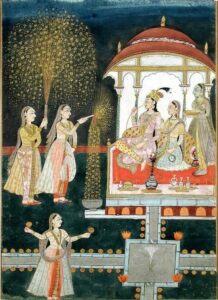
- Painting in Hyderabad started with the foundation of the Asafjhi dynasty by Mir Qamruddin Khan (Chin Qulick Khan) Nizam-ul-Mulk in 1724 A.D.
- Influence of the Mughal style of painting on the already existing early styles of Deccani paintings, introduced by several Mughal painters who migrated to the Deccan during the period of Aurangzeb and sought patronage there, was responsible for the development of various styles of painting in the Deccan at Hyderabad and other centres.
- Distinctive features of the Deccani paintings of the 18th and 19th centuries are observed in the treatment of the ethnic types, costumes, jewellery, flora, fauna, landscape and colours.
- A miniature showing a princess in the company of maids is a typical example of the Hyderabad school of painting. Typical characteristics of the Hyderabad painting like the rich colours, the Deccani facial types and costumes can be observed in the miniature. It belongs to the third quarter of the 18th century.
Tanjore
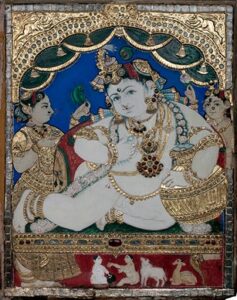
- A style of painting characterised by bold drawing, techniques of shading and the use of pure and brilliant colours flourished at Tanjore in South India during the late 18th and 19th centuries.
- A typical example of the Tanjore painting, in the collection of the National Museum, is an illustrated wooden panel of early 19th century showing the coronation of Rama. The scene is laid under elaborately decorated arches.
- In the middle Rama and Sita are seated on the throne, attended by his brothers and a lady; In the left and right panels are seen rishis, courtiers and princes. In the foreground are Hanuman, Sugriva who is being honoured and two other vanaras opening a box probably containing gifts. The style is decorative and is marked by the use of bright colours and ornamental details. The conical crown appearing in the miniature is a typical feature of the Tanjore painting.


